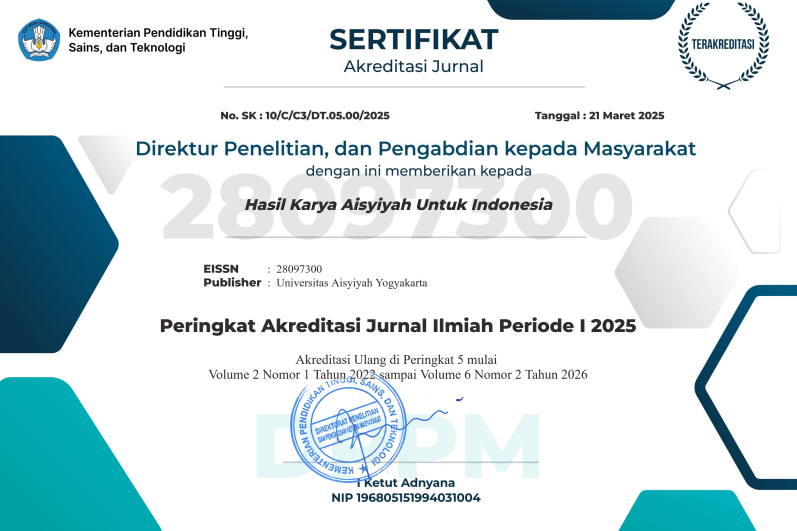Skrining penyakit tidak menular di posbindu sebagai upaya promotif dan preventif yang efektif
DOI:
https://doi.org/10.31101/hayina.4380Abstract views 114 times
Keywords:
deteksi dini, posbindu, PTM, skriningAbstract
Downloads
References
Agus Salim Burhanuddin, Katmini, & Yuly Peristiowati. (2023). Prevention Program Performance Improvement Strategy and Control of Non-Communicable Diseases at Blega Health Center, Bangkalan District. Journal for Quality in Public Health, 6(2), 332–339. https://doi.org/10.30994/jqph.v6i2.450
Azam, M., Sakinah, L. F., Kartasurya, M. I., Fibriana, A. I., Minuljo, T. T., & Aljunid, S. M. (2023). Prevalence and determinants of obesity among individuals with diabetes in Indonesia. F1000Research, 11, 1063. https://doi.org/10.12688/f1000research.125549.2
Daniel Piovani, Georgios K Nikolopoulos, & Stefanos Bonovas. (2022). Non-Communicable Diseases: The Invisible Epidemic. Journal of Clinical Medicine, i, 5939.
Dwi, F., Melati, P., & Widiany, F. L. (2021). Asupan Lemak Jenuh dengan Kadar Lipoprotein pada Kelompok Lanjut Usia Kolesterol. Jurnal Nutrisia, 23(1), 44–51. https://doi.org/10.29238/jnutri.v23i1.205
Harbuwono, D. S., Mokoagow, M. I., Magfira, N., & Helda, H. (2021). ADA Diabetes Risk Test Adaptation in Indonesian Adult Populations: Can It Replace Random Blood Glucose Screening Test? Journal of Primary Care and Community Health, 12(5). https://doi.org/10.1177/21501327211021015
Herawati, E., & Sofiatin, Y. (2021). Socio-cultural aspects of non-communicable disease prevention in three villages in the West Java. Masyarakat, Kebudayaan Dan Politik, 34(3), 340. https://doi.org/10.20473/mkp.v34i32021.340-354
Hotmarito, H., Ardiansyah, A., & ... (2023). Faktor-faktor yang Berhubungan dengan Pemamfaatan Posbindu PTM. Indonesian Journal of Nursing and Health Sciences, 4(2), 113–122. https://jurnal.globalhealthsciencegroup.com/index.php/IJNHS/article/view/1561%0Ahttps://jurnal.globalhealthsciencegroup.com/index.php/IJNHS/article/download/1561/1608
Ismail, I. (2025). Prevalence of Obesity and Its Implications for Diabetes and Hypertension Risk. Jurnal Persatuan Perawat Nasional Indonesia (JPPNI), 10(1), 100. https://doi.org/10.32419/jppni.v10i1.654
Ivana, M. F. B., & Megawat, S. (2024). Efektivitas Program Pos Pembinaan Terpadu (Posbindu) Penyakit Tidak Menular (PTM) Di Desa Nglanduk Kecamatan Wungu Kabupaten Madiun. Jurnal Ilmu Hukum, Sosial, Dan Humaniora, 2, 113–120.
Kementerian Kesehatan RI. (2017). Permenkes Nomor 5 Tahun 2017 Tentang Rencana Aksi Nasional Penanggulangan Penyakit Tidak Menular.
Marthias, T., Anindya, K., Ng, N., McPake, B., Atun, R., Arfyanto, H., Hulse, E. S. G., Zhao, Y., Jusril, H., Pan, T., Ishida, M., & Lee, J. T. (2021). Impact of non-communicable disease multimorbidity on health service use, catastrophic health expenditure and productivity loss in Indonesia: A population-based panel data analysis study. BMJ Open, 11(2), 1–13. https://doi.org/10.1136/bmjopen-2020-041870
Mohammadian Khonsari, N., Khashayar, P., Shahrestanaki, E., Kelishadi, R., Mohammadpoor Nami, S., Heidari-Beni, M., Esmaeili Abdar, Z., Tabatabaei-Malazy, O., & Qorbani, M. (2022). Normal Weight Obesity and Cardiometabolic Risk Factors: A Systematic Review and Meta-Analysis. Frontiers in Endocrinology, 13(March). https://doi.org/10.3389/fendo.2022.857930
Peltzer, K., & Pengpid, S. (2018). The Prevalence and Social Determinants of Hypertension among Adults in Indonesia: A Cross-Sectional Population-Based National Survey. International Journal of Hypertension, 2018. https://doi.org/10.1155/2018/5610725
Prameswari, R. D., Revita, N. C. T., Angraini, D. A., & Asfarina, I. (2024). Epidemiological Analysis of Non-Communicable Diseases Post-Covid Era in Indonesia. Indonesian Journal of Global Health Research, 7(1), 617–626. https://doi.org/10.37287/ijghr.v7i1.4665
Rahajeng, E. (2020). Pengutan Posbindu PTM Dalam Menurunkan Prevalensi Faktor Resiko Penyakit Tidak Menular. In Orasi Pengukuhan Profesor Riset Bidang Epidemiologi Dan Bistatistik (Vol. 44, Issue 8). Lembaga Penerbit Badan Litbangkes.
Rusyda, A. L. (2025). Exploring the Non-Communicable Disease Burden in Indonesia – Findings from the 2023 Health Survey. Indonesia Journal of Public Health Nutrition, 5(2). https://doi.org/10.7454/ijphn.v5i2.1064
Sarima Safitri, Ali Aspar Mappahya, Nurhikmawati, Wisudawan, & Asrini Safitri. (2023). Hubungan Faktor Risiko dengan Kejadian Hiperkolesterolemia Pasien Rawat Jalan Penderita Jantung Koroner di RS Ibnu Sina Makassar Tahun 2021. Fakumi Medical Journal: Jurnal Mahasiswa Kedokteran, 3(8), 552–562. https://doi.org/10.33096/fmj.v3i8.257
SKI. (2023). Survei Kesehatan Indonesia SKI. In Kementerian Kesehatan Republik Indonesia.
Sutarsa, I. N., & Nopiyani, N. M. S. (2023). Integrated primary care using a life course approach for prevention and control of non-communicable diseases: Indonesia’s perspective. Public Health and Preventive Medicine Archive, 11(1), 1–4. https://doi.org/10.53638/phpma.2023.v11.i1.p00
Wahidin, M., Agustiya, R. I., & Putro, G. (2023). Beban Penyakit dan Program Pencegahan dan Pengendalian Penyakit Tidak Menular di Indonesia. Jurnal Epidemiologi Kesehatan Indonesia, 6(2). https://doi.org/10.7454/epidkes.v6i2.6253
Wang, H., Zhang, H., Sun, L., & Guo, W. (2018). Roles of hyperuricemia in metabolic syndrome and cardiac-kidney-vascular system diseases. American Journal of Translational Research, 10(9), 2749–2763.
Xu, Q., Fan, X., Chen, G., Ma, J., Ye, W., Ai, S., Wang, L., Zheng, K., Qin, Y., Chen, L., Li, M., & Li, X. (2024). New-onset metabolic syndrome is associated with accelerated renal function decline partially through elevated uric acid: an epidemiological cohort study. Frontiers in Endocrinology, 15(February), 1–13. https://doi.org/10.3389/fendo.2024.1328404
Downloads
Published
Issue
Section
License
Copyright (c) 2025 Sulistyaningsih Sulistyaningsih, Yuriska Verina, Awwal Al-fauzia N., Muslimah Sigalingging, Thoyibatul Islami, Suriani Suriani

This work is licensed under a Creative Commons Attribution-ShareAlike 4.0 International License.
Authors who publish with Hayinajournal agree to the following terms:
- Authors retain copyright and grant the journal right of first publication with the work simultaneously licensed under a Creative Commons Attribution License (CC BY-SA 4.0) that allows others to share the work with an acknowledgment of the work's authorship and initial publication in this journal.
- Authors are able to enter into separate, additional contractual arrangements for the non-exclusive distribution of the journal's published version of the work (e.g., post it to an institutional repository or publish it in a book), with an acknowledgment of its initial publication in this journal.
- Authors are permitted and encouraged to post their work online (e.g., in institutional repositories or on their website) prior to and during the submission process, as it can lead to productive exchanges, as well as earlier and greater citation of published work.

Hayina journal is licensed under a Creative Commons Attribution-ShareAlike 4.0 International License.










